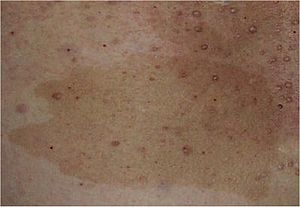Neurofibromatosis type I
type of neurofibromatosis disease
Neurofibromatosis type 1 (NF1) is a genetic condition that causes tumours (areas of not normal growth) to grow along your nerves. The tumours are usually non-cancerous (benign) but may cause a range of symptoms. NF1 is a condition you're born with, although some symptoms develop gradually over many years. The severity of the condition can vary considerably from person to person.

In most cases, the skin is affected, causing symptoms such as:
- birthmarks known as café au lait spots, which are light or dark brown patches that can be anywhere on the body
- soft, non-cancerous tumours on or under the skin (neurofibromas)
- clusters of freckles in unusual places – such as the armpits, groin and under the breast
- problems with the bones, eyes and nervous system
- Certain health problems are often associated with NF1, such as learning difficulties. Less commonly, NF1 is associated with a type of cancer known as malignant peripheral nerve sheath tumours.
Treatment
change- surgery – to remove tumours and treat problems with bones
- medicine – to control secondary conditions, such as high blood pressure
- physiotherapy
- psychological support
- pain management
Careful monitoring and treatment can help people with NF1 live a full life. However, there's a risk of developing serious problems, such as certain types of cancer, that can reduce life expectancy.